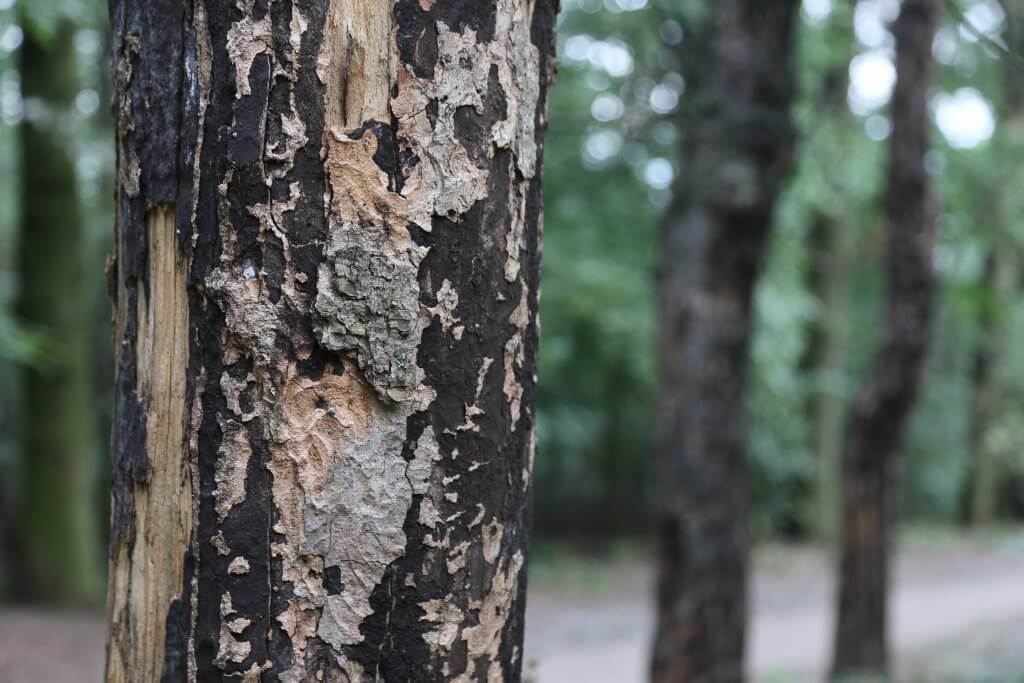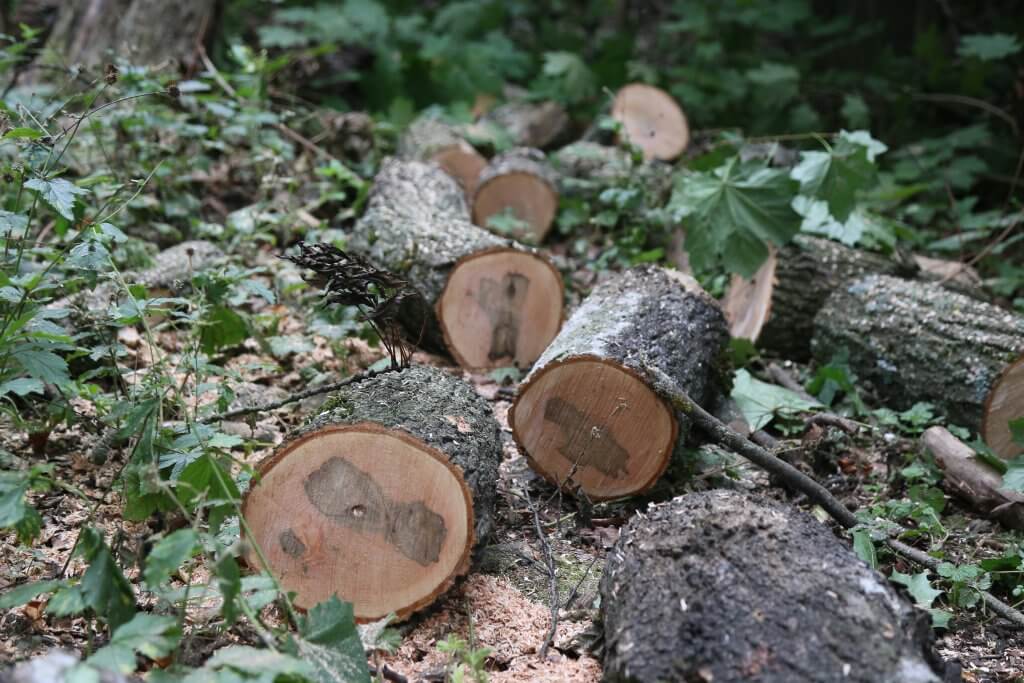Sooty bark disease in Maples is caused by the fungus Cryptostroma corticale. The Sycamore is particularly susceptible. The fungus was apparently introduced to Europe after World War II from the Great Lakes region of North America. For many decades, phytopathologists were hardly aware of it. In the last 20 years, however, it has spread practically throughout Europe. Climate change is believed to be to blame, as the disease thrives especially in hot, dry summers. Scientists from the Department of Forest Conservation and Wildlife Management at FFWT MENDELU, together with their European colleagues, used pollen monitoring samples to detect the movement of spores of this pathogen across Europe. Spores are capable of spreading hundreds of kilometres through the air.
The fungus Cryptostroma corticale, which causes the sooty disease in maple bark, thrives best in dry months with a lack of rainfall and at an average temperature of around 25 °C. In such conditions, the trees are stressed and weakened, ideal conditions for the fungus to develop: “The fungus begins to propagate and also become visible. However, it can live in the tree for many years before it is visible. It grows through the middle of the tree trunk, emerging when the time is right, into the bark layer. Within the bark, the fungus creates a reproductive body, a black mass, up to a metre wide called the stroma, which is revealed when the outer bark is broken off due to the growth of the stroma itself. At this moment, we can observe the most typical symptom of the presence of this fungus, a layer of black-brown soot – gender-neutral fungal spores, which, as we have found, can travel hundreds of kilometres thanks to air streams,” explains Miloň Dvořák from the Department of Forest Conservation and Wildlife Management.
Airborne spores can easily infect other trees through any exposed areas of wood. However, inhalation of spores can also be dangerous to humans: “They probably won’t harm a healthy person, but they can cause hypersensitivity pneumonitis in sensitive people. If left untreated, this can even cause death. Such cases were already recorded in the 1940s in North America, where the fungus was first identified. To this day, this disease is known as “maple bark peeler’s lung” and is also listed in the International Classification of Diseases,” says Dvořák, speaking of the health risks.
Scientists from FFWT MENDELU, together with colleagues from France, Switzerland, Italy, Portugal and Sweden, established cooperation in their home countries with state pollen services united under the banner of the European Aeroallergen Network (EAN). Their aim was to find out if it is possible to monitor the spread of spores of C. corticale fungus by analysis of commonly collected pollen samples. “Thanks to the willingness of the staff of these institutions, we managed to obtain samples of daily pollen captures from June to September 2018. We decided not to look for spores with a microscope, like EAN, but by isolating all DNA and then using the real-time PCR method, which needs no explanation since the covid era. However, it was not easy to isolate sufficient DNA, the samples were several years old, stored somewhere in cabinets. Moreover, they are fixed with a special solution between microscope slides, and on top of that they are stained with chemicals that can interfere with the course of the PCR reaction,” explains the researcher, on the pitfalls of sample processing.
Despite these problems, laboratory diagnostics confirmed the occurrence of C. corticale across the European continent, specifically in countries where sooty maple bark disease is currently observed, i.e. in the Czech Republic, France, Switzerland and Italy.


However, a number of questions remain unanswered for the time being, and will be the subject of further research. “Recognizing this pathogen is all the more difficult because a similar black mass of spores that can be found under the bark of maples is also produced by other fungi, but these colonize purely dead maples. Perhaps this is also the reason why this fungus has been overlooked by the scientific community for some time. We thought that the black mass was something we had known for a long time, and that it was a so-called saprophyte which occurs when the maple tree dies. There is, however, one difference, the spore mass of sooty maple bark disease is not pure black, but black-brown, it forms thicker layers of stroma than other fungi, and releases the mass into the air upon contact. All it takes is a gust of wind and a dark cloud rises from the tree,” adds Dvořák.
But it turns out that sooty maple bark disease is not only a European problem. A study trip to the west coast of the USA confirmed the occurrence of the fungus, in addition to newly reported occurrences in the states of Washington and California, as well as in Oregon. Dvořák is currently working on the development of a spore catcher: “My colleagues in Oregon and I agreed that I would try to build a cheap, small, but tailor-made spore catcher for this fungus that would allow us to monitor the spread of the fungus.” In order for monitoring to make sense, the traps must be placed over a large area, and since one standard volumetric trap used by EAN costs over 100,000 CZK, we agreed on this procedure,” explains Dvořák, an expert on fungus detection in the air.
In terms of practice, the question is whether it is possible to protect maples from the fungal pathogen C. corticale in some way: “The only thing we can do is to spread information. To teach those who are in daily contact with trees, foresters, managers of urban greenery, to prevent damage to maple trunks, because this fungus enters the tree through mechanical damage to the bark. The disease is detected mainly in maples growing in cities. This is where the trees are damaged the most, for example as a result of insensitive pruning, or on the other hand, in completely derelict brownfield sites, where maples spontaneously rejuvenate and compete aggressively for the available moisture in overgrown stands,” concludes the researcher.
Contact for further information: doc. Ing. Miloň Dvořák, Ph.D., Department of Forest Conservation and Wildlife Management FFWT MENDELU +420 775 680 314, e-mail: milon.dvorak@mendelu.cz
The research was supported under the HORIZON 2020 programme, grant no. 771271 “HOlistic Management of Emergent forest pests and Diseases” (HOMED).
More news
-
An international team of forestry scientists, led by experts from the FFWT MENDELU, have conducted a study focusing on the common (Eurasian) aspen (Populus tremula), a tree species once abundant in Central European forests but now overlooked. In…15. 5. 2024
-
Scientific team led by FFWT MENDELU experts describes 43 new species of tree…
An international scientific team led by Thomas Jung has discovered and described more than forty previously unknown species of pathogens from the genus Phytophthora which parasitize the root systems of trees. These findings are the results of a six…25. 4. 2024 -
In agricultural landscapes, a wide range of pesticide residues are spreading,…
A two-year study focused on the spread of pesticides in the food webs of various types of agricultural crops grown in South Moravia and Central Bohemia was conducted by a research team led by Radek Michalko from the Department of Forest Ecology and…8. 4. 2024 -
First joint conference of the Alpine and the Carpathian Conventions on large…
A transboundary character of wildlife populations, such as large carnivores, require enhanced international collaboration for successful conservation and management solutions. As large carnivore populations are recovering in Europe, this is even…8. 3. 2024 -
Scientist from FFWT MENDELU studies how climate affects the life of iconic…
Along with his American colleagues, dendrologist Martin Šenfeldr has studied the relationship between climate and the growth of aspen trees (Populus tremuloides) in the Great Basin region of Nevada, focusing on a period of 100 years. During the…5. 2. 2024 -
Return to coppicing supports spider biodiversity in protected lowland forests,…
Experts from the Faculty of Forestry and Wood Technology MENDELU (FFWT MENDELU) investigated how thinning forest stands and the subsequent development of the forest ecosystem affect communities of spiders living on the surface of the soil in…3. 1. 2024 -
ASFORCLIC – Adaptation strategies in forestry under global climate change impact
From January 1, 2021, to date, MENDELU - Mendel University in Brno, Czech Republic (coordinator) collaborated with seven European universities and research institutions from four European countries as a part of the EU-funded HORIZON 2020 project …12. 12. 2023 -
Czech scientists create energy from mango pellets in Cambodia
Experts from the Faculty of Forestry and Wood Technology at MENDELU are helping to make use of waste from fruit processing while reducing the consumption of firewood in Cambodia. They use the mango pellets to produce fuel briquettes, which are then…21. 11. 2023 -
Scientists take samples of driftwood in northern Norway. They aim to find out…
Scientists from FFWT MENDELU have completed a second mission in search of driftwood to the northern coast of Norway. As in 2022, they took samples of driftwood, which will be analysed in the MENDELU dendrochronological and anatomical laboratory. In…30. 10. 2023 -
LDF researchers help kick-start forestry in Aragvi, Georgia
Georgia’s Aragvi – a newly established protected landscape area (PLA) of almost 100,000 hectares – is located in three separate valleys about 80 km north of the Georgian capital Tbilisi. “We are working in an area with harsh winters, sultry summers…28. 8. 2023